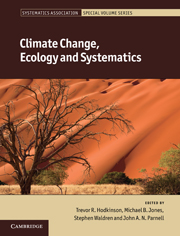Book contents
- Frontmatter
- Contents
- List of contributors
- Preface
- Section 1 Introduction
- Section 2 Adaptation, speciation and extinction
- 4 Global climate and extinction: evidence from the fossil record
- 5 Long-term fluctuations in atmospheric CO2 concentration influence plant speciation rates
- 6 Wood anatomy and climate change
- 7 Savanna biome evolution, climate change and the ecological expansion of C4 grasses
- 8 Climate warming results in phenotypic and evolutionary changes in spring events: a mini-review
- 9 Terrestrial green algae: systematics, biogeography and expected responses to climate change
- Section 3 Biogeography, migration and ecological niche modelling
- Section 4 Conservation
- Index
- Systematics Association Publications
- Plate section
- References
7 - Savanna biome evolution, climate change and the ecological expansion of C4 grasses
from Section 2 - Adaptation, speciation and extinction
Published online by Cambridge University Press: 16 May 2011
- Frontmatter
- Contents
- List of contributors
- Preface
- Section 1 Introduction
- Section 2 Adaptation, speciation and extinction
- 4 Global climate and extinction: evidence from the fossil record
- 5 Long-term fluctuations in atmospheric CO2 concentration influence plant speciation rates
- 6 Wood anatomy and climate change
- 7 Savanna biome evolution, climate change and the ecological expansion of C4 grasses
- 8 Climate warming results in phenotypic and evolutionary changes in spring events: a mini-review
- 9 Terrestrial green algae: systematics, biogeography and expected responses to climate change
- Section 3 Biogeography, migration and ecological niche modelling
- Section 4 Conservation
- Index
- Systematics Association Publications
- Plate section
- References
Summary
Abstract
This chapter discusses the abiotic (climatic, atmospheric, fire) and biotic (herbivory, competition) factors driving the origin of savanna biomes and the evolution of their dominant plant group, the grasses. C4 photosynthesis is a key innovation in grass evolution, and we outline how phylogenetic approaches have helped us understand the multiple origins of this trait and the factors driving its evolution, such as atmospheric CO2 concentrations, drought, heat and fire. C4 grasses have interacted closely with other organisms throughout their evolution, and we describe evidence for their coevolution with ungulate herbivores in savanna habitats (an evolutionary arms-race scenario). We also describe phylogenetic approaches for reconstructing ancestral niches and geographical ranges of grasses over evolutionary time. These studies reveal a close link between climate and savanna evolution, with the first C4 grasses evolving in open habitats of Africa. By reviewing the findings of several major studies, we hope to provide predictions about the fate of savannas under future global change scenarios.
Introduction
Biomes are natural communities of wide geographical extent, characterised by distinctive, climatically controlled groups of organisms (Raven et al., 2005). Savannas are among the most charismatic of such biomes because they are extremely species-rich, because their predominantly C4 grasses coevolved with a large diversity of mammalian grazers, and because their history is intimately linked with the opening up of tropical forests that occurred during the Cenozoic (in the last 65 million years), due to climate change. C4 grasses exhibit the Hatch–Slack photosynthetic pathway (Slack and Hatch, 1967).
- Type
- Chapter
- Information
- Climate Change, Ecology and Systematics , pp. 156 - 175Publisher: Cambridge University PressPrint publication year: 2011
References
- 2
- Cited by

